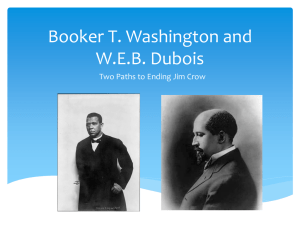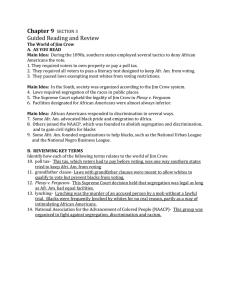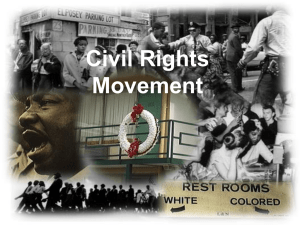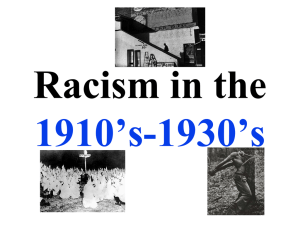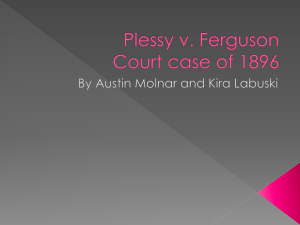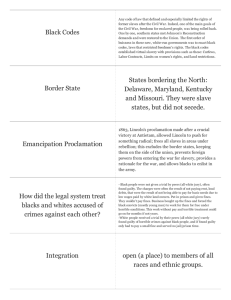File
advertisement
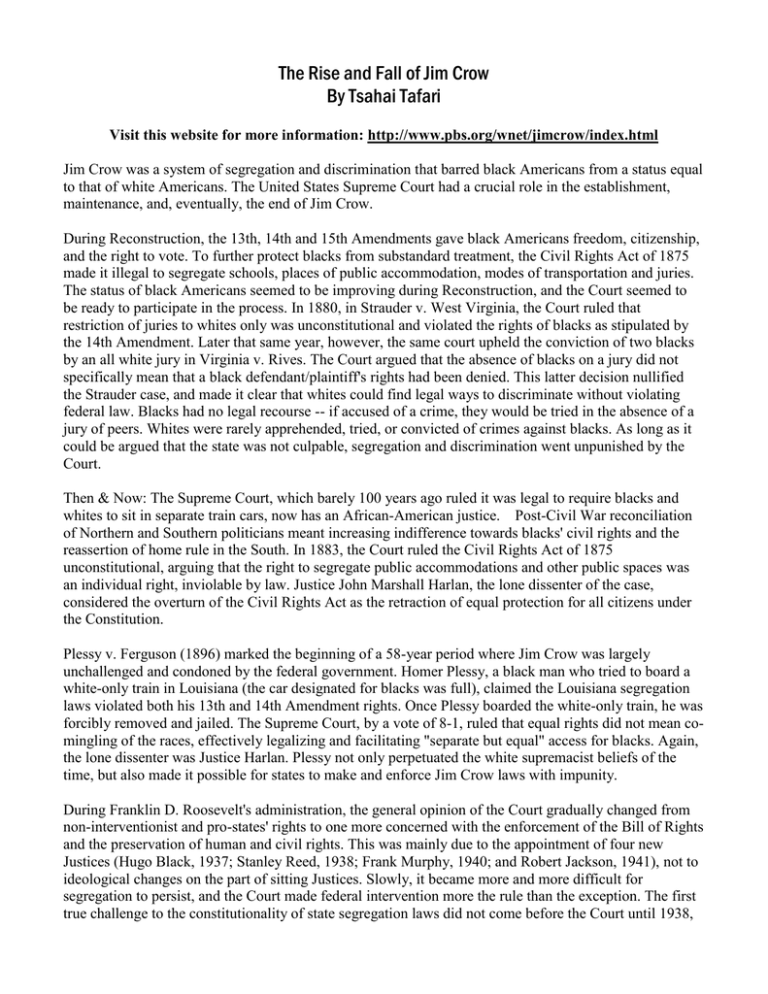
The Rise and Fall of Jim Crow By Tsahai Tafari Visit this website for more information: http://www.pbs.org/wnet/jimcrow/index.html Jim Crow was a system of segregation and discrimination that barred black Americans from a status equal to that of white Americans. The United States Supreme Court had a crucial role in the establishment, maintenance, and, eventually, the end of Jim Crow. During Reconstruction, the 13th, 14th and 15th Amendments gave black Americans freedom, citizenship, and the right to vote. To further protect blacks from substandard treatment, the Civil Rights Act of 1875 made it illegal to segregate schools, places of public accommodation, modes of transportation and juries. The status of black Americans seemed to be improving during Reconstruction, and the Court seemed to be ready to participate in the process. In 1880, in Strauder v. West Virginia, the Court ruled that restriction of juries to whites only was unconstitutional and violated the rights of blacks as stipulated by the 14th Amendment. Later that same year, however, the same court upheld the conviction of two blacks by an all white jury in Virginia v. Rives. The Court argued that the absence of blacks on a jury did not specifically mean that a black defendant/plaintiff's rights had been denied. This latter decision nullified the Strauder case, and made it clear that whites could find legal ways to discriminate without violating federal law. Blacks had no legal recourse -- if accused of a crime, they would be tried in the absence of a jury of peers. Whites were rarely apprehended, tried, or convicted of crimes against blacks. As long as it could be argued that the state was not culpable, segregation and discrimination went unpunished by the Court. Then & Now: The Supreme Court, which barely 100 years ago ruled it was legal to require blacks and whites to sit in separate train cars, now has an African-American justice. Post-Civil War reconciliation of Northern and Southern politicians meant increasing indifference towards blacks' civil rights and the reassertion of home rule in the South. In 1883, the Court ruled the Civil Rights Act of 1875 unconstitutional, arguing that the right to segregate public accommodations and other public spaces was an individual right, inviolable by law. Justice John Marshall Harlan, the lone dissenter of the case, considered the overturn of the Civil Rights Act as the retraction of equal protection for all citizens under the Constitution. Plessy v. Ferguson (1896) marked the beginning of a 58-year period where Jim Crow was largely unchallenged and condoned by the federal government. Homer Plessy, a black man who tried to board a white-only train in Louisiana (the car designated for blacks was full), claimed the Louisiana segregation laws violated both his 13th and 14th Amendment rights. Once Plessy boarded the white-only train, he was forcibly removed and jailed. The Supreme Court, by a vote of 8-1, ruled that equal rights did not mean comingling of the races, effectively legalizing and facilitating "separate but equal" access for blacks. Again, the lone dissenter was Justice Harlan. Plessy not only perpetuated the white supremacist beliefs of the time, but also made it possible for states to make and enforce Jim Crow laws with impunity. During Franklin D. Roosevelt's administration, the general opinion of the Court gradually changed from non-interventionist and pro-states' rights to one more concerned with the enforcement of the Bill of Rights and the preservation of human and civil rights. This was mainly due to the appointment of four new Justices (Hugo Black, 1937; Stanley Reed, 1938; Frank Murphy, 1940; and Robert Jackson, 1941), not to ideological changes on the part of sitting Justices. Slowly, it became more and more difficult for segregation to persist, and the Court made federal intervention more the rule than the exception. The first true challenge to the constitutionality of state segregation laws did not come before the Court until 1938, the case of Missouri ex rel Gaines v. Canada. A black student, Lloyd Gaines, was denied admission to the white-only State University of Missouri Law School, so he took legal action. The Court affirmed Plessy (6-2), and did not require Missouri to accept Gaines at the Law school. Instead, since Missouri had no black law school, the University had to pay for blacks to go to law school out of state or build a facility similar to that provided for white students. By legally making the maintenance of segregation an expensive and complicated alternative to integration, Gaines was the first of a series of cases that led to the overturning of Plessy. Thurgood Marshall, NAACP Counsel and civil rights leader, coordinated several key victories before the Supreme Court that resulted in the dismantling of Jim Crow. Morgan v. Virginia (1946 ) challenged the Virginia law requiring passenger motor vehicle carriers to separate white and black passengers. The state law was struck down, as it was found to place undue burden on interstate commerce, and desegregated interstate travel. Shelley v. Kraemer (1948) ruled that a state court could not constitutionally restrict an American from occupying a property on the basis of race, desegregating housing. These cases clearly enforced the 14th Amendment, and demonstrated that equality and separation were increasingly antithetical. Did You Know: Thurgood Marshall, appointed by President Lyndon B. Johnson in 1967, was the first African American to serve on the U.S. Supreme Court. Next, Marshall mounted a well-planned assault on Jim Crow in the educational system by arguing Sweatt v. Painter (1950) and McLauren v. Oklahoma State Regents (1950). In Sweatt, a case against the University of Texas Law School, the Court ruled that the black facilities provided by the university did not meet the standard of equality, so black students could not be excluded from the white facilities. In McLauren, the Court ruled that Oklahoma could not restrict itself to white students, as separate black facilities removed the important educational opportunity for students to interact with one another. Additionally, McLauren supported black students' right to equality as guaranteed by the 14th Amendment. Mc Lauren and Sweatt forced integration of graduate and professional schools, and significantly, there were no dissenters in either case. Though Plessy was not re-examined in these cases, the stage was set for its overturn in undergraduate and precollegiate educational facilities. Marshall used these victories to prepare himself and the Court for a direct attack on Plessy v. Ferguson. In four cases known collectively as Brown v. Board of Education (1954, 55), Marshall argued that segregation was inherently unconstitutional, and that it denied an entire race the equal protection guaranteed by 14th Amendment. Chief Justice Earl Warren was a skilled negotiator, and garnered a unanimous decision in which the Court ruled that "'separate but equal' has no place" in America's public schools, as separate was deemed inherently unequal. Jim Crow was suddenly at odds with the law of the country, and openly threatened white supremacy. Though the legality of Jim Crow in education had been defeated, blacks continued to struggle for equal rights in its wake.
